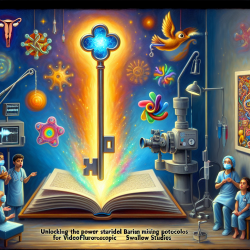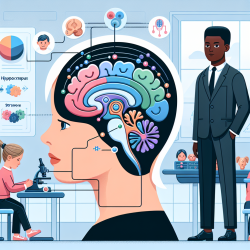Introduction
In the realm of speech-language pathology, understanding the intricate connections between sensory systems is crucial for developing effective therapeutic strategies. A recent study titled "Altered white matter structure in auditory tracts following early monocular enucleation" sheds light on how early vision loss can lead to significant changes in the auditory system. This research provides valuable insights that can be leveraged to improve outcomes in speech therapy, particularly for children with sensory impairments.
The Study at a Glance
The study conducted by Wong et al. (2019) investigated the structural changes in the auditory system of adults who underwent early monocular enucleation, a procedure involving the removal of one eye. By using diffusion tensor imaging (DTI), the researchers examined four key auditory and audiovisual tracts. They found that participants with early monocular enucleation exhibited significant asymmetries in these tracts compared to binocularly intact controls. These changes were particularly evident in the fractional anisotropy (FA) values, which indicate the coherence of fiber orientation in white matter tracts.
Implications for Speech Therapy
Understanding these structural changes opens up new avenues for enhancing speech therapy techniques. Here are some practical applications:
- Enhanced Multisensory Integration: The study highlights the brain's remarkable ability to adapt to sensory loss by enhancing other sensory pathways. Speech therapists can incorporate multisensory approaches, such as integrating auditory and visual stimuli, to strengthen neural connections and improve language processing in children with sensory impairments.
- Tailored Therapy Plans: Recognizing the unique structural adaptations in children with early sensory loss allows therapists to tailor interventions that leverage these changes. For instance, focusing on auditory training exercises that enhance sound localization and discrimination can be particularly beneficial.
- Crossmodal Training: Encouraging crossmodal training, where children engage in activities that require coordination between different sensory modalities, can promote neuroplasticity and enhance overall communication skills.
Encouraging Further Research
While this study provides a foundational understanding of the impact of early monocular enucleation on auditory pathways, there is still much to explore. Practitioners are encouraged to delve deeper into the following areas:
- Longitudinal Studies: Conducting longitudinal studies to track the long-term effects of sensory loss on brain structure and function can provide valuable insights into the most effective therapeutic interventions.
- Functional MRI Studies: Utilizing functional MRI to explore the functional consequences of structural changes in the auditory system can help identify specific areas of the brain that can be targeted in therapy.
- Comparative Studies: Comparing the outcomes of different therapeutic approaches in children with varying degrees of sensory loss can help refine and optimize treatment plans.
Conclusion
The findings from this study underscore the importance of a holistic approach to speech therapy that considers the interconnectedness of sensory systems. By integrating these insights into practice, speech-language pathologists can enhance their therapeutic strategies and ultimately improve outcomes for children with sensory impairments.
To read the original research paper, please follow this link: Altered white matter structure in auditory tracts following early monocular enucleation.










